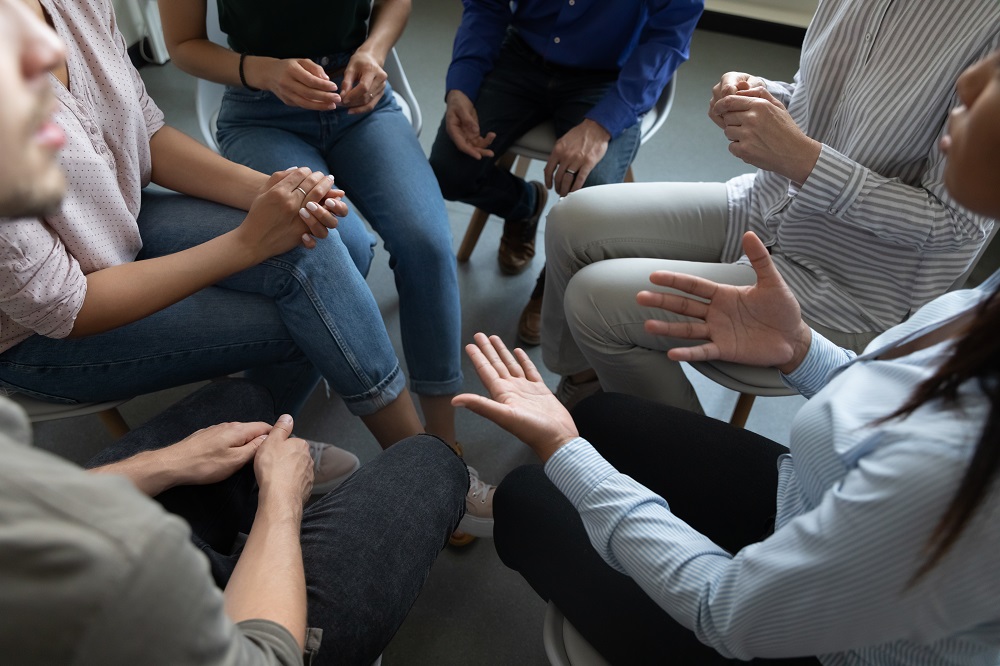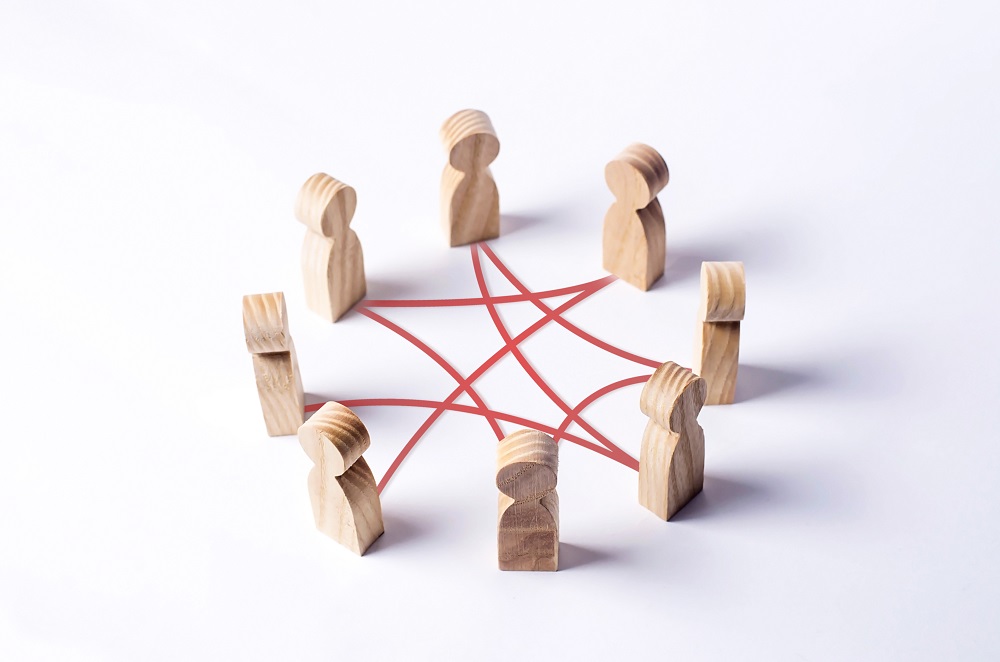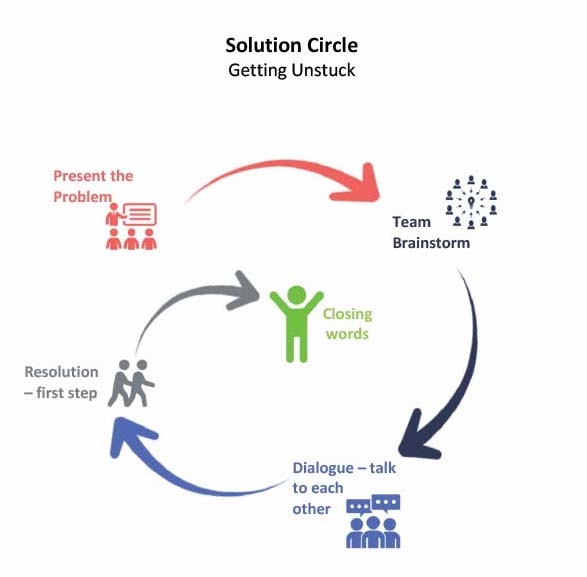Solution-focused approaches to coaching advocate that people are inherently resourceful and creative. It therefore stands to reason that, under the right conditions if we can facilitate groups effectively and in a collaborative way, the potential for even better ideas and outcomes will follow.
This all sounds great in theory. It does however take purposeful intention and skill to work in a solution-focused way with both individuals and in groups. There can be more potential for more creative and resourceful outcomes when working at a group level. Although there also exists more risk for forces (sometimes outside of your control) to destabilise groups. This can sometimes give rise to unhelpful group dynamics and undermine what is trying to be achieved. In short, the stakes are higher when there are more relationships involved. So, thinking carefully about how you structure the group and facilitate the sessions can be a vital successful ingredient.

The Origin of Solution Circles
Solution Circles is a technique that was originally developed by Jack Forrest and Marsha Pearpoint. Jack and Marsha are recognised as visionary and inspirational leaders in the field of educational inclusion in North America. Adopting a natural extension of Solution-Focused thinking, Jack and Marsha held the powerful belief that people, in whatever setting, have the capacity to help others, if only they are given the right opportunities to do so. Jack and Marsha were able demonstrate the power of this belief through the creation of a number of different ‘circle approaches’, which help to produce the conditions to make this possible.
Through their approach they adopted a very solution-focused mindset of noticing and keeping what works. Jack and Marsha quickly came to recognise the power of combining circles with clear roles, clear purpose and just enough structure to find the balance between discipline and freedom. Solution Circles were developed with these factors in mind.
Getting Unstuck – the Stages of a Solution Circle
Using a Solution Circle is a structured process in which all participants work through the following four stages:
- Description of the problem
- Brainstorming solutions and idea generation
- Problem clarification and discussion
- Next steps/actions.
Each stage lasting 6 minutes each.
Step 1: Description of the problem: The ‘Problem-Presenter’ shares their problem, whilst the rest of the group listens. If the problem presenter finishes before the time is up, the group are instructed to remain silent, in case other things emerge that the problem presenter wants to share.
Step 2: Brainstorming solutions and ideas: The group contribute ideas, based on what they have heard. It is not a time for asking clarifying questions. It is the Problem Presenter’s turn to just listen.
Step 3: Problem clarification and discussion: The group now have a dialogue and the Problem Presenter can respond to what they have heard. Now is the chance to clarify and explore the problem further. The focus here is on what is positive and can be done.
Step 4: Next steps and actions: The Problem Presenter decides on which actions they want to do next. There is a stipulation that one of the steps must be something that can be done in the next 24 hours and the other steps should be acted upon within 3 days. The Problem Presenter then chooses someone to ‘check-in’ with them to see if they have taken the first step.
The Roles Within Solution Circles
The Problem Presenter: The focus person who shares their problem.
The Process Facilitator: Also known as the Time Keeper.
The Note Taker: The person who note takes and agrees to reflect back what has been said at the end of each stage. This would be a good role initially for the coach to take or somebody who is already familiar with the process.
The Brainstorming Team: The remaining group members who help to come up with creative solutions.
The Solution in Solution Circles
Solution Circles were initially created in order to help promote the inclusion of children / young people with Special Educational Needs (SEN). Over time, people have come to realise that Solution Circles are powerful. This is because it is effective in creating the right conditions for change. And here’s why…
- Circles are equal and inclusive. A good start.
- The structure keeps it simple.
- The structure strikes a good balance between allowing structure, whilst also allowing flexibility. The structure means that conversations remain focused and on-task. Whilst nothing says ‘we are listening’ more than respecting the space for silence and having a person whose sole purpose is to repeat back key information at each stage.
- Literature of resilience continually advocates the need for the building of both social relationships and problem-solving abilities. Solution Circles do both of these things.
- The purpose is clear from the beginning. To allow an exploration of the issues and to agree 2-3 next steps.
- Everybody’s role is clearly defined.
- There is ownership. The Problem Presenter owns the problem, but there is a recognition that the problem exists within a larger system and that everybody involved can have an important role in helping.
- It is respectful of people and their capacity for change. There is a focus on what is manageable, achievable and doable.
Solution Circle Work Even Better When …
Don’t mistake simple for easy. The skill as a facilitator is making things flow and seem easy. If you are wanting to experiment with using Solution Circles in groups. Here are some pointers which we would recommend.
- Groups work best when they know what to expect. We recommend providing members of the group with a brief one-page summary of the process.
- The Note Taker is the most difficult role. As a facilitator, who may be introducing this tool to a group, it is recommended that you volunteer for this role initially, so that you can model to those involved how this looks.
- Be confident to tweak and experiment the Solution Circles formula. As long as it stays true to the original Solution-Focused principles. In our experience, in can be helpful for the Note Taker to add in a brief +1 part between Stage 1 and 2, which is simply to clarify with the Problem Presenter what specifically the ‘hot issues’ are. This ensures that discussions among the participants do not go ‘off-piste’ and instead are more closely aligned with the Problem Presenter’s experiences. We call this the Solution Circles +1 Approach.
- Solution Circles can be quite intense. Our experience shows us that it can be valuable to agree a 5-minute coffee break in between Steps 3 & 4. This gives people additional time and space to reflect and gives the Problem Presenter more time to decide what their best next steps are.
- In order to create sustained change, we recommend that Solution Circles are used as part of a regular schedule. This means that participants get to practise doing Solution Circles and get better at them. This enables double loop learning to occur. Learning about the issue at hand and learning about how to do Solution Circles.
About us:
We create the space for leaders to step back, think clearly, and navigate complexity with confidence. By sharpening the narrative that drives decisions, teams, and performance, we help leaders move forward with clarity and impact. Our approach blends deep listening, incisive challenge, and commercial focus—strengthening leadership at every level, from business transformation to boardroom decisions.
“We share resources that help coaches deepen their practice and expand their impact. The articles on this site are designed to spark fresh thinking, offer practical tools, and support the continuous growth of coaches at every stage. “
Jude Elliman
Founder
Our Core Approach:
We work with leaders to sharpen their thinking, strengthen their leadership, and navigate complexity with confidence. Our approach is built around three core areas:
Narrative Coaching – Working with the stories that shape leadership, teams, and organisations.
Commercial Focus – Cutting through complexity to drive clear, strategic decisions.
Challenge & Space – Asking the right questions while creating the space to reflect and grow.
Through this, we help leaders drive transformation, align teams, and make high-stakes decisions with clarity and impact.



